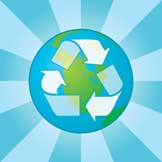|
Plastics
& the Environment
|
|
||
|
Natural Weight Loss
Program recommended by The Share Guide
|
In the northern Pacific Ocean lies the Great Garbage Patch, an island of garbage floating on-and-just-below the surface. This is a tragic byproduct of the fossil plastics industry and consumerism that was originally the size of Texas and is now approaching twice that size. This gargantuan pile of plastic is collected by currents that swirl around the ocean in a big circle. Most of the debris is picked up from the shores of China and North America. So how did we get here? Some experts have estimated that 25% of all plastics made are non-accountable, wandering and slowing degrading in nature. A significant amount of plastic does not get recycled, incinerated, or landfilled. These are primarily microscopic pieces, too fine to collect with nets. The plastic is in our food chain now and even in our bodies. But what about those numbered triangles on all the plastic packaging? We are all recycling, right? Well, not exactly. First, just what do those numbers represent? And do they really get recycled? The answers to these questions may surprise you. There are 7 types of plastic, each with a number inside the "chasing arrows" triangle on the package. Here's what these numbers represent: #1 - Polyethylene Terephthalate (PET) #2 - High Density Polyethylene (HDPE) #3 - Vinyl (Polyvinyl Chloride or PVC) #4 - Low Density Polyethylene (LDPE) #5 - Polypropylene (PP) #6 - Polystyrene (PS) #7 - Other (commonly includes: polycarbonate, ABS, nylon, acrylic, or a composite of two or more resins) According to a 2006 EPA study, fossil plastics represent 12% of the landfill space (up from 0.4% in 1960). Plastic packaging represents 60% of the plastic in the landfill (up from 25% in 1960). The total recovery rate for all plastics in 2006 was only 6.9% and that combines recycling rates and incineration rates (i.e. not landfilled). Although much is made of the "waste-to-energy" business, it is NOT recycling, and the resource is lost. There are also significant issues with air pollution from incineration. The best recycling rates match up to the rigid plastics that have the most curbside recycling: plastic soft drink and water bottles (#1, PET) recycled at a 30.9% rate, and #2 (HDPE) milk jugs recycled at 31%. Of all the plastics used for containers and packaging, only 10.6% were recycled. Plastic packaging comes in two main forms: rigid, like salad tubs, jars, and bottles; and film, like wraps and bags. For fossil plastic packaging, of the 14 possible combination of numbers 1-7 and rigid plus film, only 5 resin types had any significant market for recycling. The rest just do not have recycling markets, thus the myth of the chasing arrows. Even if you can recycle plastic, the recycling number represents only the base polymer, as there are additives and colorants in addition to the base resin, which contaminate the stream's recyclability. Think of water with a bit of indigo ink dropped in it for color--might be pretty, but makes it useless to drink! Yet another twist: most of the plastics that are recycled get 'downcycled' into lesser value. I do not think that recycling is supposed to mean "only one more life"--that's just a time delay trick to the inevitable trash. What can you do? Check container bottoms for recycling codes and choose those that are accepted for recycling in your area. The most commonly recycled plastics are #1 (PET) or #2 (HDPE). Look for plastics with recycled content; for instance, recycled content #1 PET will say "rPET." Plastics to avoid: Steer clear of PVC vinyl (#3) whose manufacture and incineration releases carcinogenic dioxins into the environment and food chain. PVC often contains lead and toxic plasticizers such as phthlates that can migrate into food, water, air, and our mouths. Also avoid plastics that are often not recyclable and leach chemicals suspected of disrupting hormone functions: #3, #6, and #7. Tom Wright is the founder of Sustainable Bizness Practices. Learn more at www.sustainablebizness.com. Related Info: Toxins In Your Home The Hazards of Household Cleaning Products The Dangers of Electromagnetic Radiation WIFI: Friend or Foe? Global Warming: Myths and Facts Natural Weight Loss Program recommended by The Share Guide: learn more MORE
ARTICLES Home Health Store |
||
|
|
|||
|
|
|
||



 If
you liked this article, you'll
love The Share Guide's
If
you liked this article, you'll
love The Share Guide's